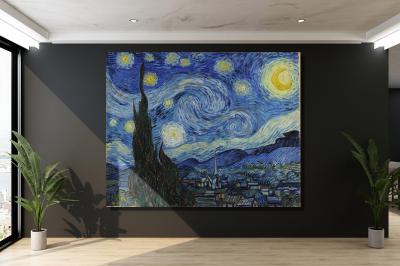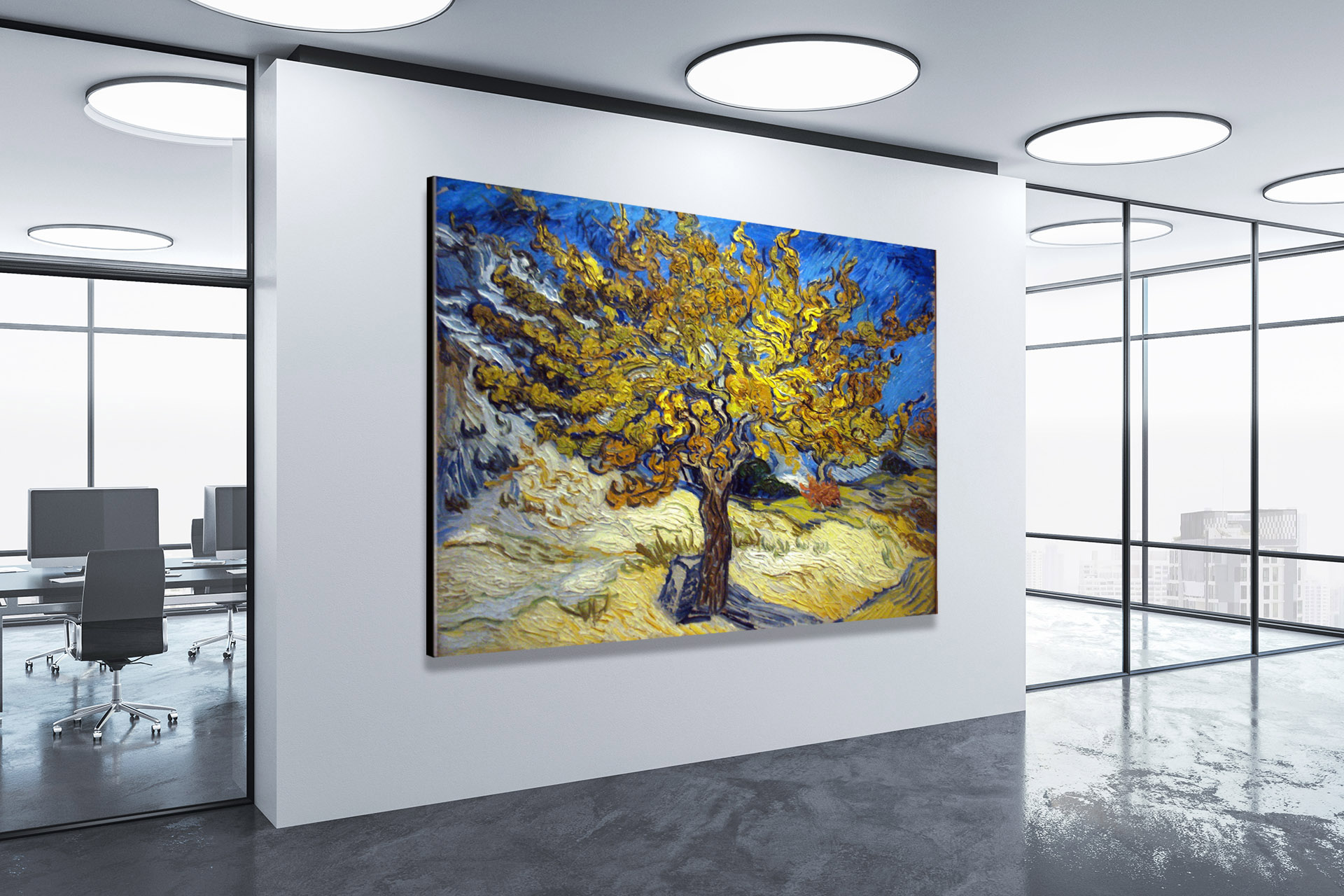The Mulberry Tree
By Vincent van Gogh, 1889
The Mulberry Tree: Vincent van Gogh’s Masterpiece of Hope and Beauty
Within the tapestry of art history, few names shine as resplendently as Vincent van Gogh. His turbulent life and mesmerizing artworks continue to enthrall art enthusiasts and scholars alike. Among his many masterpieces, “The Mulberry Tree” stands as a confirmation to his unique artistic genius, indomitable spirit, and profound connection with the natural world. In this article, we embark on an immersive journey into the world of Vincent van Gogh’s “The Mulberry Tree,” exploring its origins, symbolism, technical challenges, location, significance, and the artist’s deep emotional connection with this extraordinary work.
The Genesis of “The Mulberry Tree”
Painted in October 1889, “The Mulberry Tree” epitomizes van Gogh’s iconic Post-Impressionist style. During this pivotal period of his life, van Gogh sought refuge in the Saint-Paul-de-Mausole asylum in Saint-Rémy-de-Provence, France. The asylum’s gardens provided a sanctuary where he could immerse himself in the splendor of nature’s beauty while grappling with the tumultuous currents of his mental anguish.
“The Mulberry Tree” sprang to life from van Gogh’s intense contemplation of the world around him. The tree itself, a magnificent mulberry tree, took center stage in his artistic vision. Van Gogh portrayed the tree with a keen eye for its vitality and resilience, set starkly against the barrenness of its surroundings. The sky, swirling with shades of blue and white, adds dynamism and energy to the composition, a reflection of the artist’s own emotional turmoil.
“The Mulberry Tree” Large Canvas Prints from WhiteClouds
Technical Challenges
Creating “The Mulberry Tree” was no easy feat for van Gogh. He faced numerous technical challenges during its execution. Van Gogh’s signature impasto technique, characterized by thick, textured layers of paint, presented difficulties in capturing the intricate details of the mulberry tree’s leaves and branches. The bold impasto strokes, however, also impart a palpable sense of energy and movement to the painting, which is now celebrated as one of its defining features.
The Location of the Painting
“The Mulberry Tree” was painted in the garden of the Saint-Paul-de-Mausole asylum in Saint-Rémy-de-Provence, France. This location holds deep significance in van Gogh’s life and artistic journey. The asylum’s tranquil gardens, with their diverse flora and peaceful atmosphere, served as a wellspring of inspiration for the artist during his turbulent times. The mulberry tree itself stood as a symbol of life’s resilience amid adversity, something with which van Gogh deeply identified.
Symbolism and Emotion
As is characteristic of many of van Gogh’s works, “The Mulberry Tree” is richly imbued with symbolism and deep emotion. The mulberry tree, with its steadfast trunk and tenacious branches, serves as a metaphor for the artist’s own unwavering determination and perseverance in the face of life’s adversities. Like the tree, van Gogh stood tall, casting his protective artistic shadow over his own desolate landscape.
The swirling sky in the background functions as a visual representation of van Gogh’s internal tempest. It communicates his inner turmoil, the maelstrom of thoughts and emotions that roiled within him. However, amidst this tumult, there is an undercurrent of hope and optimism that pervades the painting. The vibrant colors and the tree’s resolute stance convey a longing for beauty and tranquility in the midst of chaos.
Legacy and Impact
“The Mulberry Tree” remains an iconic masterpiece within van Gogh’s extensive body of work, residing in the hallowed halls of the Van Gogh Museum in Amsterdam. It continues to inspire and captivate art lovers and scholars from across the globe. Its enduring popularity attests to the timeless allure of van Gogh’s art and the universal themes of beauty, resilience, and hope that it conveys.
Vincent van Gogh: A Painter’s Journey
Vincent Willem van Gogh was born on March 30, 1853, in Zundert, Netherlands. His artistic journey was marked by intense passion and an unwavering dedication to his craft. Despite suffering from mental health issues, poverty, and personal challenges, van Gogh produced a staggering body of work that continues to resonate with audiences worldwide.
Van Gogh’s style evolved throughout his career, from his early works influenced by dark, somber colors to the vibrant, emotionally charged canvases of his later years. His unique brushwork and bold use of color set him apart from his contemporaries.
Sadly, van Gogh’s life was fraught with struggles. He endured periods of mental instability, including the infamous incident in which he severed his own ear. Despite these challenges, he found solace and inspiration in the natural world, which he depicted in paintings such as “The Mulberry Tree.”
Vincent van Gogh’s legacy endures not only through his artwork but also through the profound impact he had on the art world. His ability to convey deep emotions through color and form, as seen in “The Mulberry Tree,” continues to influence artists and art lovers alike, reminding us of the enduring power of creativity and the human spirit’s ability to find beauty in even the darkest of times.
 The Mulberry Tree by Vincent van Gogh
The Mulberry Tree by Vincent van Gogh
Conclusion
Vincent van Gogh’s “The Mulberry Tree” transcends mere paint and canvas; it is a portal into the depths of the artist’s soul. It confirms his ability to discern beauty in the most unlikely of places, to channel his inner turmoil into a masterpiece that radiates hope and resilience. As we contemplate this extraordinary work of art, we are reminded of the enduring power of creativity to transcend pain and suffering, to transform the ordinary into the extraordinary. In “The Mulberry Tree,” van Gogh bequeaths us a legacy of beauty, strength, and the enduring possibility of discovering light in even the darkest of times. It stands as a symbol of hope, a testament to the indomitable human spirit, and a source of eternal inspiration for generations to come.
Frequently Asked Questions About “The Mulberry Tree”
Where is “The Mulberry Tree” currently located? “The Mulberry Tree” is housed at the Van Gogh Museum in Amsterdam, Netherlands.
What is the significance of the mulberry tree in the painting? The mulberry tree is often interpreted as a symbol of resilience and hope, reflecting van Gogh’s own struggles and his ability to find beauty in the midst of adversity.
When was “The Mulberry Tree” painted? Vincent van Gogh painted “The Mulberry Tree” in October 1889, during his stay at the Saint-Paul-de-Mausole asylum in Saint-Rémy-de-Provence, France.
What is the style of “The Mulberry Tree”? “The Mulberry Tree” is painted in Vincent van Gogh’s signature Post-Impressionist style, characterized by bold brushwork, vivid colors, and the use of impasto techniques.
What is the size of the painting? The dimensions of “The Mulberry Tree” are approximately 73.6 x 92.1 cm (29 x 36 1/4 in).
How did van Gogh achieve the thick texture in the painting? Van Gogh achieved the thick texture and impasto effect in “The Mulberry Tree” by applying layers of oil paint with a palette knife or his fingers, creating a tactile and three-dimensional quality.
What inspired van Gogh to paint “The Mulberry Tree”? The garden of the Saint-Paul-de-Mausole asylum, where van Gogh was staying at the time, inspired him to paint “The Mulberry Tree.” The tree itself, along with its surroundings, held personal significance for the artist.
Are there any other notable paintings related to mulberry trees by van Gogh? Yes, van Gogh painted several works featuring mulberry trees, including “Mulberry Tree” (1889), “Mulberry Tree in Autumn” (1889), and “Mulberry Bush” (1889).
What emotions or themes does “The Mulberry Tree” convey? “The Mulberry Tree” conveys themes of resilience, hope, and the beauty found in nature. It also reflects van Gogh’s own emotional turmoil and his quest for tranquility.
How has “The Mulberry Tree” influenced the art world? “The Mulberry Tree” is a testament to van Gogh’s ability to express deep emotions through art, influencing subsequent generations of artists and serving as an enduring symbol of artistic creativity and perseverance.
Is “The Mulberry Tree” considered one of van Gogh’s masterpieces? Yes, “The Mulberry Tree” is widely regarded as one of Vincent van Gogh’s masterpieces, celebrated for its beauty, symbolism, and the emotions it conveys.
Are there any specific details or techniques in “The Mulberry Tree” that art enthusiasts should pay attention to? Art enthusiasts may want to examine the thick impasto texture of the leaves and branches, the vibrant color palette, and the swirling sky in the background, all of which contribute to the painting’s unique visual and emotional impact.
Other Articles on Vincent van Gogh Paintings
At Eternities Gate by Vincent Van Gogh, 1890
Blossoming Almond Tree by Vincent Van Gogh, 1890
Cafe Terrace at Night by Vincent Van Gogh, 1888
Daubigneys Garden by Vincent Van Gogh, 1890
Green Wheat Field with Cypress by Vincent Van Gogh, 1889
Houses at Auvers by Vincent Van Gogh, 1890
Irises by Vincent Van Gogh, 1889
Night Café by Vincent Van Gogh, 1888
Portrait of Dr. Gachet by Vincent Van Gogh, 1890
Red Vineyards by Vincent Van Gogh, 1888
Road with Cypress and Star by Vincent Van Gogh, 1890
Starry Night by Vincent Van Gogh, 1889
Starry Night over the Rhone by Vincent Van Gogh, 1888
Sunflowers by Vincent Van Gogh, 1887
The Bedroom by Vincent Van Gogh, 1888
The Church at Aurers by Vincent Van Gogh, 1890
The Garden of the Asylum by Vincent Van Gogh, 1889
The Mulberry Tree by Vincent Van Gogh, 1889
The Potato Eaters by Vincent Van Gogh, 1885
The Yellow House by Vincent Van Gogh, 1888
Tree Roots by Vincent Van Gogh, 1890
Van Gogh Self Portrait by Vincent Van Gogh, 1887
Vase with Red Poppies by Vincent Van Gogh, 1886
View of Arles by Vincent Van Gogh, 1889
Wheat Field with Crows by Vincent Van Gogh, 1890
Wheat Field with Cypresses by Vincent Van Gogh, 1889
More WhiteClouds Videos
Contact us today to learn more about our 3D services and how we can help you achieve your goals.

